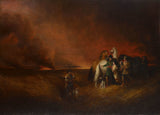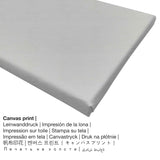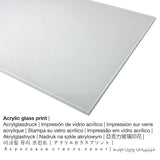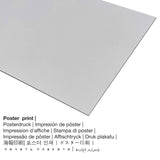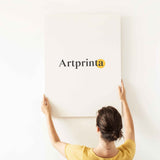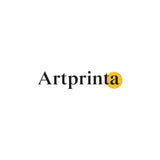Alvan Fisher, 1827 - The Prairie on Fire - ọmarịcha nka
Ụtụ gụnyere. Mbupu gbakọrọ na ndenye ọpụpụ.
Nchịkọta nke oyiri
Nke a karịrị 190 afọ ọrụ nka aha ya The Prairie on Fire e kere ya Alvan Fisher. Ụdị nke nka nwere nha: 61 × 83,8 cm (24 × 33 na). Mmanụ na kwaaji was applied by the artist as the technique for the piece of art. The original artwork is inscribed with the information: signed, dated, and inscribed on verso, prior to lining: Painted by Alvan Fisher 1827. Nowadays, the work of art is in the the digital collection of Ụlọ ọrụ Art Chicago, which is one of the world’s great art museums, housing a collection that spans centuries and the globe. We are happy to mention that the artwork, which belongs to the ngalaba ọha a na-enye ya site n'ikike nke Ụlọ ọrụ Art Chicago. Ihe kredit nke artpiece bụ nke a: Through prior acquisition of the George F. Harding Fund; restricted gift of Jamee J. and Marshall Field; Americana Endowment Fund. Na mgbakwunye na nke a, nhazi ahụ bụ odida obodo na a akụkụ ruru nke 1.4: 1, nke pụtara na ogologo bụ 40% ogologo karịa obosara.
Họrọ ngwa ngwaahịa gị
N'ime ndetu ndetu ngwaahịa ị nwere ike họrọ ihe na nha masịrị gị. Anyị na-ahapụ gị ka ịhọrọ n'ime ụdị ndị a:
- Mbipụta akwụkwọ mmado (akwa akwa akwa): The poster print is a UV printed cotton canvas paper with a nice surface texture. The poster is designed for putting the fine art print using a custom-made frame. Please keep in mind, that depending on the absolute size of the poster we add a white margin of approximately 2 - 6cm around the print motif, which facilitates the framing with your custom frame.
- Mbipụta enyo acrylic: An print on acrylic glass, often denoted as a print on plexiglass, will transform the artwork into marvellous décor. In addition to that, the acrylic glass print forms a viable alternative option to canvas or aluminium dibond fine art replicas. The work of art is manufactured with state-of-the-art UV direct printing technology. It makes vivid, deep colors. Our real glass coating protects your custom art print against light and external influences for decades.
- Aluminom dibond mbipụta (ọla): Aluminium Dibond prints are metal prints with an impressive effect of depth. A direct Aluminium Dibond Print is the excellent start to fine art replicas on aluminum. For our Direct Print On Aluminum Dibond, we print the artpiece right onto the aluminium surface. The bright parts of the artpiece shimmer with a silk gloss but without glare.
- Mbipụta kwaaji: A canvas print is a printed cotton canvas stretched on a wood frame. Your canvas print of this artwork will give you the unique opportunity of transforming your into a large artwork like you would see in a gallery. A canvas print has the advantage of being relatively low in weight, which means that it is quite simple to hang up your Canvas print without additional wall-mounts. Therefore, a canvas print is suitable for all types of walls.
Ihe dị mkpa: We try to describe the art products in as much detail as it is possible and to display them visually in our shop. Although, some colors of the printed materials, as well as the printing may diverge slightly from the image on your monitor. Depending on the screen settings and the condition of the surface, not all color pigments can be printed as realisitcally as the digital version on this website. Given that all art reproductions are processed and printed manually, there might also be minor discrepancies in the motif's exact position and the size.
Nkọwapụta ihe
| Nkewa edemede: | nka nka |
| Usoro mmeputakwa: | dijitalụ mmeputakwa |
| Usoro mmepụta: | Mbipụta UV ozugbo |
| Ihe ngosi: | emepụtara na Germany |
| Ụdị ngwaahịa: | na mmepụta ihe |
| Ojiji ngwaahịa: | nka mgbidi, art mmeputakwa gallery |
| Nhazi: | usoro odida obodo |
| Oke akụkụ: | ogologo ruo obosara 1.4: 1 |
| Akụkụ onyonyo pụtara: | ogologo bụ 40% ogologo karịa obosara |
| Ụdị ihe dị iche iche: | Mpempe akwụkwọ, akwụkwọ mmado (akwụkwọ akpa), mbipụta enyo acrylic (nwere ezigbo mkpuchi iko), mbipụta ọla (aluminium dibbond) |
| Mbipụta kanvas (akwa akwa na etiti ihe ndọtị): | 70x50cm - 28x20", 140x100cm - 55x39" |
| Mbipụta iko acrylic (nwere ezigbo mkpuchi iko) dị iche iche: | 70x50cm - 28x20", 140x100cm - 55x39" |
| Mpempe akwụkwọ mmado (akwụkwọ kwaaji) nha dị iche iche: | 70x50cm - 28x20" |
| Nhọrọ aluminom dibond (ihe aluminom) nhọrọ: | 70x50cm - 28x20", 140x100cm - 55x39" |
| Nhazi nke nnomi nka: | na-enweghị etiti |
Ozi ndabere na nka pụrụ iche
| Aha nke ọrụ nka: | "The Prairie on Fire" |
| Nhazi nka: | sere |
| Nhazi nka: | nkà nke oge a |
| Time: | 19th narị afọ |
| Emepụtara n'afọ: | 1827 |
| Ogologo afọ nka nka: | 190 afọ |
| Ihe osise izizi: | mmanụ na kwaaji |
| Ogo nke ọrụ nka izizi: | 61 × 83,8 cm (24 × 33 na) |
| Akara aka na nka nka: | signed, dated, and inscribed on verso, prior to lining: Painted by Alvan Fisher 1827 |
| Egosiputara na: | Ụlọ ọrụ Art Chicago |
| Ebe ngosi nka: | Chicago, Illinois, Njikota Obodo Amerika |
| Weebụsaịtị ihe ngosi nka: | Ụlọ ọrụ Art Chicago |
| License: | ngalaba ọha |
| Site n'aka: | Ụlọ ọrụ Art Chicago |
| Ebe E Si Nweta: | Through prior acquisition of the George F. Harding Fund; restricted gift of Jamee J. and Marshall Field; Americana Endowment Fund |
Ozi izugbe na onye na-ese ihe
| Ihe nkiri: | Alvan Fisher |
| okike onye nka: | nwoke |
| Obodo onye nka: | American |
| Ọrụ: | onye na-ese ihe |
| Obodo onye nka: | United States |
| Otu nka: | omenkà nke oge a |
| Oge ndu: | 71 afọ |
| Afọ ọmụmụ: | 1792 |
| Afọ nwụrụ: | 1863 |
© echebe nwebiisinka | Artprinta (www.artprinta.com)
Nkọwa nka nka izizi nke Art Institute Chicago (© Nwebiisinka - Art Institute Chicago - Ụlọ ọrụ Art Chicago)
Alvan Fisher was a pioneering American landscapist whose work offered an important precedent for the Hudson River School. This painting depicts a subject from James Fenimore Cooper’s 1827 novel The Prairie, the third of the five Leatherstocking Tales. In this scene, Natty Bumppo, the hero of the series, has created a firebreak to protect the story’s protagonists. As a Romantic-era artist, Fisher preferred such dramatic episodes, which involved striking contrasts between light and dark. Unlike contemporaneous illustrations of the scene, which give little sense of setting, in this version the figures are dwarfed by nature, and the prairie grasses are exquisitely rendered, underscoring the landscape’s beauty as well as its dangers. The work thus suggests the significance of the prairie in Cooper’s text. Perhaps for this reason, the author declared that it was “the only good illustration he had seen from his books.”

